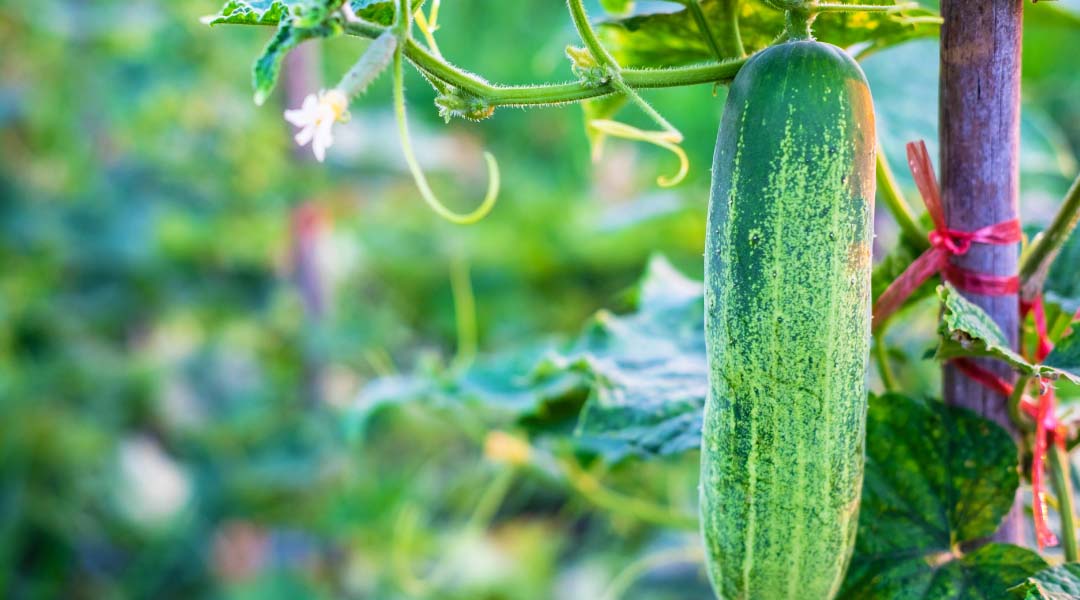Cucumbers are a delightful addition to any garden, offering a refreshing crunch to salads and a perfect base for pickles. Growing cucumbers in a garden bed not only enhances your gardening experience but also provides you with an abundant harvest that’s fresher and tastier than anything store-bought. This comprehensive guide will walk you through each step of cultivating cucumbers in your garden bed, ensuring you achieve a bountiful yield.
Brief Overview of Cucumbers
Cucumbers (Cucumis sativus) are part of the gourd family, Cucurbitaceae, which includes squash, melons, and pumpkins. They come in various types, including slicing cucumbers, which are perfect for fresh eating, and pickling cucumbers, which are smaller and ideal for making pickles. English cucumbers, known for their thin skin and fewer seeds, are often used in salads and sandwiches. Rich in water content and nutrients like vitamin K and potassium, cucumbers are a low-calorie food that is great for hydration and overall health.
Why Grow Cucumbers in a Garden Bed
Growing cucumbers in a garden bed offers numerous advantages. The controlled environment of a garden bed allows you to manage soil quality, moisture levels, and spacing more effectively. This leads to healthier plants and higher yields. Garden beds also make it easier to implement companion planting strategies, which can enhance the growth and flavor of your cucumbers. Additionally, the elevated structure of a garden bed reduces the risk of pests and diseases that often plague ground-level gardening.
Selecting the Right Location
The success of your cucumber crop starts with choosing the right location. Cucumbers thrive in full sunlight, requiring at least 6 to 8 hours of direct sunlight daily. This ensures that they have enough energy to produce healthy leaves and fruits. The soil should be well-drained to prevent waterlogging, which can lead to root rot and other issues. Avoid low-lying areas where water tends to accumulate after rain.
Soil Preparation
Soil quality is paramount when growing cucumbers. Begin by testing the soil pH; cucumbers prefer a slightly acidic to neutral pH range of 6.0 to 7.0. If your soil is too acidic, you can add lime to raise the pH, or if it’s too alkaline, sulfur can help lower it. Incorporate organic matter like compost or well-rotted manure into the soil to improve its fertility and structure. Aim for a soil depth of at least 12 inches to provide ample space for root development. Well-prepared soil ensures that your cucumber plants have access to the nutrients and moisture they need to thrive.
Designing the Garden Bed Layout
Proper spacing is crucial for healthy cucumber plants. Space your plants 12 to 18 inches apart to allow for adequate air circulation and room for growth. Crowded plants are more susceptible to disease and produce smaller yields. Consider companion planting to naturally repel pests and improve soil health. Marigolds, for example, deter nematodes, while radishes can ward off cucumber beetles. However, avoid planting cucumbers near potatoes, as they can attract similar pests and compete for nutrients.
Choosing and Planting Cucumber Seeds or Seedlings
Selecting Cucumber Varieties
Choosing the right cucumber variety depends on your climate, garden space, and intended use. For small gardens, consider bush varieties that don’t require much space. If you have vertical space, vining varieties can be trained up trellises, maximizing your yield. If you live in a cooler climate, look for varieties labeled as “cold-tolerant” or with shorter growing seasons. For pickling enthusiasts, choose smaller, bumpier varieties, while those who enjoy fresh cucumbers in salads might prefer the smoother, larger slicing varieties.
Starting Seeds Indoors vs. Direct Sowing
Deciding between starting seeds indoors or direct sowing depends on your local climate and the length of your growing season. Starting seeds indoors 3 to 4 weeks before the last frost date gives your plants a head start, especially in regions with short growing seasons. Use peat pots or seed trays filled with a light, well-draining potting mix. Once the danger of frost has passed, harden off the seedlings by gradually exposing them to outdoor conditions before transplanting them into your garden bed.
Direct sowing is simpler and works well in warmer climates. Plant seeds directly in the garden bed once the soil temperature reaches at least 70°F (21°C). Sow seeds 1 inch deep and 6 inches apart, thinning them to 12 to 18 inches apart once they’ve developed a few true leaves.
Planting Process
Whether you’re transplanting seedlings or sowing seeds directly, the process is straightforward. For seedlings, dig a hole slightly larger than the root ball, place the seedling in the hole, and gently backfill with soil. Water immediately to help the plant settle. For direct sowing, place seeds about 1 inch deep in the soil, cover lightly with soil, and water well. Ensure consistent moisture during germination, which typically occurs within 7 to 10 days.
Care and Maintenance
Watering Requirements
Cucumbers need consistent moisture to produce juicy, flavorful fruits. Water deeply and regularly, aiming to keep the soil evenly moist but not waterlogged. A good rule of thumb is to provide about 1 inch of water per week, increasing during hot, dry spells. Water in the morning to reduce the risk of fungal diseases and direct water at the base of the plants to keep the leaves dry.
Fertilizing Cucumbers
Fertilizing is essential to support the vigorous growth of cucumber plants. Start with a balanced fertilizer, such as a 10-10-10 formula, at the time of planting. As the plants grow and begin to flower, switch to a fertilizer higher in potassium and phosphorus to encourage fruit production. Be cautious not to over-fertilize, as excessive nitrogen can lead to lush foliage with few fruits.
Mulching
Mulching is a simple yet effective way to conserve moisture, regulate soil temperature, and suppress weeds. Apply a 2- to 3-inch layer of organic mulch, such as straw, shredded leaves, or compost, around the base of your cucumber plants. Mulch also helps to prevent soil-borne diseases by reducing soil splashing onto the leaves during watering.
Supporting Cucumber Plants
Vining cucumber varieties benefit greatly from support structures like trellises, cages, or stakes. Supporting your plants keeps the fruits off the ground, reducing the risk of rot and pest damage. It also improves air circulation around the plants, which helps prevent fungal diseases. Trellising cucumbers can save space in your garden bed and make harvesting easier.
Pest and Disease Management
Cucumbers are prone to pests like cucumber beetles, aphids, and spider mites, as well as diseases like powdery mildew and downy mildew. To manage pests, consider using insecticidal soap or neem oil as organic control methods. Introducing beneficial insects like ladybugs and lacewings can also help keep pest populations in check. For disease prevention, practice crop rotation, space plants properly to ensure good air circulation, and remove any infected plant material promptly.
Harvesting Cucumbers
When to Harvest
The timing of your cucumber harvest depends on the variety and your intended use. For fresh eating, harvest slicing cucumbers when they are 6 to 8 inches long and still firm to the touch. Pickling cucumbers should be harvested when they reach 3 to 4 inches in length. Check your garden daily, as cucumbers can grow quickly and become overripe if left too long on the vine.
How to Harvest
To harvest cucumbers, use a sharp pair of garden shears or scissors to cut the stem just above the fruit. Alternatively, you can twist the cucumber gently until it detaches from the vine. Avoid pulling or yanking, as this can damage the plant. Regular harvesting encourages the plant to produce more fruits throughout the growing season.
Storing and Using Cucumbers
After harvesting, store cucumbers in a cool, dry place or in the refrigerator to keep them fresh for up to a week. For longer storage, consider pickling your cucumbers or making cucumber relishes. Cucumbers can also be used in a variety of dishes, from refreshing salads and sandwiches to smoothies and cold soups.
Troubleshooting Common Problems
Yellowing Leaves
Yellowing leaves can be a sign of several issues, including overwatering, nutrient deficiency, or disease. If the yellowing is accompanied by wilting, check your watering habits and soil drainage. A balanced fertilizer application can correct nutrient deficiencies. If you suspect disease, remove affected leaves and improve air circulation around the plants.
Poor Fruit Development
If your cucumbers are small or misshapen, inadequate pollination or nutrient imbalances may be to blame. Ensure your garden attracts pollinators by planting flowers nearby. You can also hand-pollinate by transferring pollen from male to female flowers using a small brush. If poor fruit development persists, test your soil and adjust fertilization as needed.
Managing Environmental Stress
Cucumbers are sensitive to extreme temperatures and environmental stress. During heatwaves, provide shade or mulch to keep the soil cool. In drought conditions, increase watering frequency. If a sudden cold snap threatens, cover your plants with row covers or blankets to protect them.
Conclusion
Growing cucumbers in your garden bed is a rewarding experience that offers fresh, delicious produce right from your backyard. By selecting the right location, preparing the soil, and choosing the best varieties, you set the foundation for a successful harvest. With proper care, including regular watering, fertilizing, and pest management, your cucumber plants will thrive.
Don’t be intimidated by the process—cucumbers are one of the easiest vegetables to grow, even for beginners. The satisfaction of harvesting and enjoying your homegrown cucumbers is well worth the effort. Plus, with a little attention and care, you’ll be rewarded with an abundant crop that can be enjoyed in countless ways.
Additional Resources
For more tips on growing cucumbers and other vegetables, consider joining a local gardening club or seeking advice from experienced gardeners in your community. Online forums and gardening blogs can also be valuable resources for troubleshooting problems and sharing success stories. Happy gardening!
This detailed guide should equip you with all the knowledge you need to grow cucumbers successfully in your garden bed. Whether you’re a novice or an experienced gardener, the rewards of growing your cucumbers are immense—from the joy of nurturing a plant to the pleasure of eating fresh, homegrown produce.


0 Comments